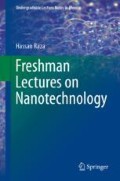Abstract
One may envision that nanofabrication also involves two approaches. The first is the top-down approach where the nanostructures are fabricated by patterning and etching material. The second is the bottom-up approach towards nanofabrication, which is based on how the nature works, i.e. engineering the building blocks in a way that they fit together under the right conditions.
Access this chapter
Tax calculation will be finalised at checkout
Purchases are for personal use only
Notes
- 1.
III–V materials consist of atoms from group III and group V, e.g. Gallium Arsenide, widely used for LEDs and LASER devices. II–VI materials consist of atoms from group II and group VI, e.g. Cadmium Telluride, used for night vision devices.
References
Crommie et al., Science 262, 218 (1993)
Kim et al., Science 257, 375 (1992)
Matsuda et al., Appl. Phys. Lett. 78, 1508 (2001)
Barrett et al., J Appl. Phys. 70, 2725 (1991)
Author information
Authors and Affiliations
Corresponding author
Appendices
Problems
9.1 Give an example of PVD method for nanoparticle/nanocrystal growth.
9.2 Give an example of PVD method for nanowire growth.
9.3 Give an example of PVD method for nanofilm growth.
9.4 Give an example of CVD method for nanoparticle/nanocrystal growth.
9.5 Give an example of CVD method for nanowire growth.
9.6 Give an example of CVD method for nanotube growth.
9.7 Give an example of CVD method for nanofilm growth.
9.8 Which method is used for growing materials for night vision applications?
9.9 Give an example of molecular self-assembly process not discussed in this chapter for growing nano particles or quantum dots.
9.10 Give an example of molecular self-assembly process not discussed in this chapter for growing nanofilms.
9.11 What is the state of the art resolution in electron-beam lithography.
9.12 What is the state of the art resolution in nanoimprint lithography.
9.13 What is the state of the art resolution in SPM (AFM and STM) based lithography.
Research Assignment
R9.1 Defense applications of nanotechnology include materials (armor, fuselage), bullet-proof textiles, sensors (physical, chemical, biological), devices (MEMS, NEMS, Micro/Nano Electromechanical Systems), actuators, lab-on-chip, guidance and control, power systems like batteries, intelligent and smart systems, soldier support system, etc. Pick a topic of your choice about the role of nanotechnology in contemporary defense industry, and write a one-page summary.
Rights and permissions
Copyright information
© 2019 Springer Nature Switzerland AG
About this chapter
Cite this chapter
Raza, H. (2019). Nanofabrication. In: Freshman Lectures on Nanotechnology. Undergraduate Lecture Notes in Physics. Springer, Cham. https://doi.org/10.1007/978-3-030-11733-7_9
Download citation
DOI: https://doi.org/10.1007/978-3-030-11733-7_9
Published:
Publisher Name: Springer, Cham
Print ISBN: 978-3-030-11731-3
Online ISBN: 978-3-030-11733-7
eBook Packages: Physics and AstronomyPhysics and Astronomy (R0)

